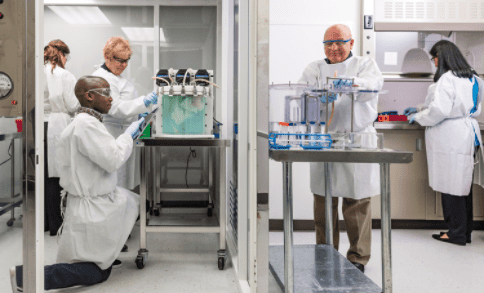
Credit: University of Texas Medical Branch at Galveston.
In a landmark study of regenerative medicine, researchers at the University of Texas Medical Branch (UTMB) have transplanted bioengineered lungs into adult pigs, with no visible complications. This puts us one step closer to providing human patients in dire need of a transplant with the organs they need to survive.
According to the U.S. Department of Health & Human Services, 20 people die each day waiting for a transplant. Lung transplants are particularly problematic, with the number of people requiring one increasing worldwide, while the number of available transplantable organs has decreased. Lungs are harvested from only 15 percent of all cadaveric donors, whereas kidneys and livers are harvested from 88 percent and hearts from 30 percent of deceased donors
The first human lung transplant procedure was performed in 1963, and the recipient survived 18 days, ultimately succumbing to renal failure and malnutrition. Over time, the number of lung transplant procedures has increased, and the operation is now an accepted treatment for end-stage lung disease. In 2015, there were 4,122 adult lung transplants reported — and that’s not nearly enough. But what if it was possible to grow new, personalized organs for each patient in need of a transplant? Certainly, thousands of lives would be saved each year — and, today, we’re nearing such a goal.
“Our ultimate goal is to eventually provide new options for the many people awaiting a transplant,” said Nichols, professor of internal medicine and associate director of the Galveston National Laboratory at UTMB.
For years, Joan Nichols and Joaquin Cortiella from The University of Texas Medical Branch at Galveston have been working on bioengineering lungs. In 2014, they were the first to grow lung cells in a lab, and their method has been refined ever since to the point that the team is now able to bioengineer transplantable lungs.
The challenges were numerous, of course. For one, in terms of different cell types, the lung is probably the most complex of all organs. For instance, the cells near the entrance are very different from those deep in the lung,
The procedure first starts with a support scaffold, a protein structure of collagen and elastin onto which the new lung will grow. The scaffold is placed in a tank filled with a solution made of nutrients and the pig’s own lung cells, following a carefully designed protocol.
For 30 days, the bioengineered lungs grew in a bioreactor before being transplanted into adult pigs. The medical condition of the animals was assessed at ten hours, two weeks, one month, and two months following the operation, which allowed the team to construct a timeline of the lung tissue’s development. For instance, in just two weeks, the transplanted lungs had established a stable network of blood vessels, which it needs in order to survive.
All of the pigs that received the bioengineered lung remained healthy.
“We saw no signs of pulmonary edema, which is usually a sign of the vasculature not being mature enough,” the researchers wrote. “The bioengineered lungs continued to develop post-transplant without any infusions of growth factors, the body provided all of the building blocks that the new lungs needed.”
This study was only meant to evaluate how well a bioengineered lung could adapt to an adult host organism, with positive results so far. However, the team did not measure how much oxygenation the lungs had provided, which will be researched in the future. And, if all goes well, Nichols and Cortiella hope to grow and transplant bioengineered lungs into people within 5 to 10 years. Besides transplants, bioengineered lungs are a great testing medium for experimental drugs, another line of work that can save countless lives.
“It has taken a lot of heart and 15 years of research to get us this far, our team has done something incredible with a ridiculously small budget and an amazingly dedicated group of people,” they wrote.
The findings appeared in the journal Science Translational Medicine.









